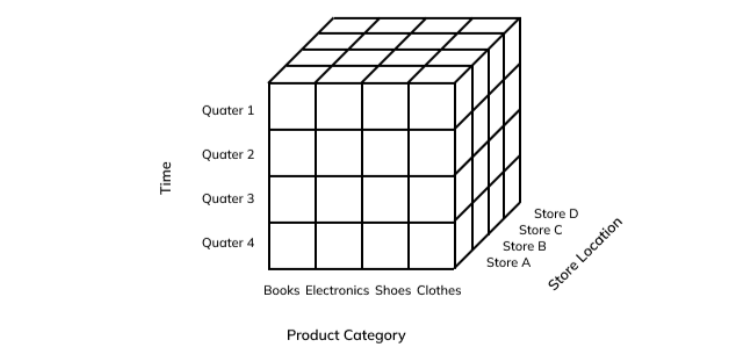OLAP and OLTP
OLAP (Online Analytical Processing)
OLAP systems help analyze large amounts of data quickly by organizing it into multiple dimensions.
- Optimized for analysis, not transactions
- Converts two-dimensional data into a multidimensional format
- Supports "slicing and dicing" to explore data from different angles
Example:
A company tracks sales data by region, year, and product. OLAP allows analysts to break down total sales for each dimension and drill into specific details.
OLAP Cube
The OLAP cube is a multidimensional database that speeds up data analysis.
- Each dimension represents a category (e.g., region, year, product)
- Values (e.g., total sales) are stored at the intersections of dimensions
- Supports quick aggregations and breakdowns of data
Example:
If a cube has three dimensions (Time, Product, Store Location), analysts can retrieve total sales for Q1, Electronics, Store A or compare sales trends across different quarters.

Hypercubes
Hypercubes are OLAP cubes with more than three dimensions, allowing for even more complex data analysis.
Example:
A hypercube with four dimensions (Time, Product, Store Location, Customer Age Group) enables analysts to retrieve total sales for Q1, Electronics, Store A, Age 25-34 or compare trends across different age groups.
OLTP (Online Transaction Processing)
OLTP systems handle fast, simple transactions like updates and lookups.
- Optimized for frequent, small transactions
- Used for applications like banking, reservations, and retail sales
- Typically affects only a few rows at a time
Example:
A retail system updates a customer's balance after each purchase. The OLTP system records the transaction instantly but does not perform complex analysis.
Example: Credit Card Company
A data engineer at a credit card company maintains an OLTP system to track customer purchases in real time. However, for analyzing spending patterns, his team uses an OLAP system that organizes purchases by year, age group, and location.
- OLAP is for analyzing large datasets using a multidimensional approach.
- OLTP is for fast, real-time transactions affecting small amounts of data.
OLAP uses multidimensional data for complex queries, while OLTP relies on traditional database tables (rows and columns).